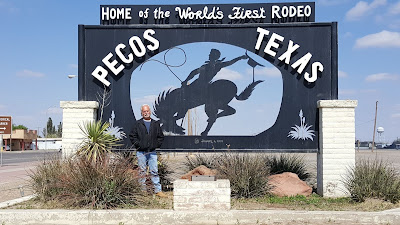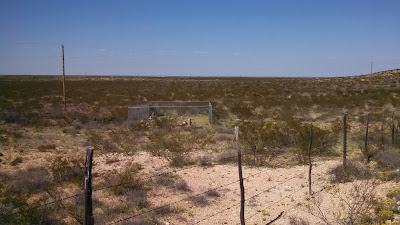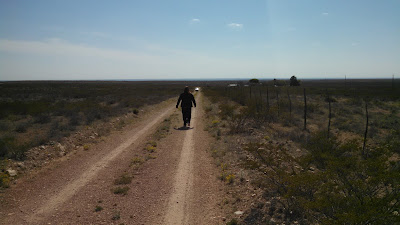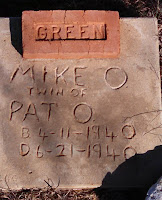Today's Geocaching Adventure took us on a Presidential drive to a historical home. After a busy 6-day work week, it was good to get out and do some exploring. We decided to relax this time out instead of our recent hikes. Taking time for a good home cooked breakfast, we headed east on I-20 into Midland, Texas. Our first stop was a Starbucks since we haven't had one in a long while!
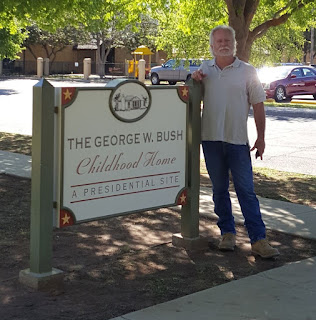 Our first Geocache was a Presidential Virtual! (GC89D4) The home of TWO Presidents! From the historical sign out front:
Our first Geocache was a Presidential Virtual! (GC89D4) The home of TWO Presidents! From the historical sign out front: "George Herbert Walker Bush and wife Barbara came to Texas in 1948, moving to Midland with their young son George Walker Bush in 1950. They bought this house in 1951 and while here faced the loss of their daughter Robin and celebrated the birth of two sons. The years spent here were vital for young George, who attended Sam Houston Elementary, made lifelong friends and played baseball. The family moved to a larger home in 1955 and then later moved to Houston.
This c. 1939 traditional style house reflects transition from Tudor to Ranch detailing. Unique in history, it was home to two Presidents: George H. W. and George W. Bush; two Governors: George W. Bush (TX) and Jeb Bush (FL); and First Lady Barbara Bush."
However, while we were there it hadn't opened yet for the day. It was Sunday around 11:00 AM and we weren't up for waiting a couple of hours for an inside tour. Maybe next time we're in the area.
Leaving the downtown presidential home, we continued east several miles outside the city of Midland to another of Texas' historical marker caches. This one was located near Midland County's first producing oil well (GC2A3Q4). There wasn't much to actually SEE at this spot, but here's what the historical marker reads:
The discovery of oil in the Permian Basin during the 1920's helped sustain the area economy during The Great Depression, and many oil and gas companies established headquarters in Midland. Not until the 1940's, though, did Midland County begin seeing its own productive wells. Geologist H. L. Beckman worked with the Rowan Drilling Company to stake out Humble Oil and Refining Company's No.1 Mrs. O.P. Buchanan oil well at this site. They spudded the well on September 14, 1944 and completed it on November 6, 1945 at a total depth of 12,574 feet. The well produced 332 barrels of oil in 29 hours and became Midland County's first producing oil well. It was plugged on August 1, 1947.
On the way to our next cache, we arrived in Garden City and the Glasscock County Courthouse and Jail. On May 9, 1893, a little over one month from the date of Glasscock County's formal organization, the first county commissioner's court issued bonds to erect a combination courthouse / jail buildings. The small 2-story structure was completed on February 12, 1894. Originally, the ground floor was used for court session and the 2nd story for the jail. On August 27, 1910, a larger building was completed and has been in continual use since 1910. The smaller building was then used entirely as the jail until a new one replaced it in 1980.
A few blocks away was the Garden City Cemetery and our next Geocache (GC30CB1). We couldn't get the cache located in the cemetery as there was a gardener mowing right near the cache location. The one we did find was located outside the cemetery near the entrance.
The next cache on the agenda was for another Texas ghost town (GC14VV1). Not much to see here except for the historical marker:
The pioneer settlement of Cummins developed at this site about 1890 around the saddle and harness shop of the earliest permanent settler, Mississippi native Robert Benjamin Cummins (b. 1848). A post office the following year the nearby town of Sterling City (1.9 miles east) was founded. The two towns became rivals for the designation of county seat when the Texas Legislature created Sterling County from Tom Green County on March 4, 1891. An intense publicity campaign developed, aided by the writings of the respective town newspaper editors: W. L. Thurman of the Cummins paper, the "North Concho News", and S. R. Ezzell of the "Sterling Courier". An election, conducted May 20, 1891, appeared to be a victory for Cummins until several voting boxes were dismissed for technical reasons, resulting in a tie. A second election on July 7 gave Sterling City a 13-vote margin and it was named the county seat. Most Cummins businesses and residents had moved to Sterling City by the end of 1891. Nothing remains of the early townsite, which once included a school, saloon, meat market, mercantile, blacksmith shop, and grocery stores.
Now that you know the story of the rivalry between Cummins and Sterling City, let's drive over to see what all the fuss was about. Arriving at the newer Sterling County Court House, you can still see the original 1912 County Jail building to the right of it. Like most of the old west jails we've seen, the lower level included living quarters for the sheriff and this one had seven jail cells on the upper floor.
Across the street from the courthouse was this restored 1910 Hotel. Although I think the upper floors are still used as guest rooms or apartments, the lower floor appears to be an antique store.
A few blocks away was an old train depot. There wasn't a cache placed there, but I noticed the historical sign pointing the way to it and had to check it out. Attracted by the area's livestock production, nearby shipping points, and the financial support of the town, the Concho, San Saba & Llano Valley Railroad began building a line to Sterling City in 1909. A boxcar served as the depot until this mission revival building was completed. Highway and pipeline construction caused a decline in rail traffic and the line closed in 1958. Only this restored depot remains as a reminder of the early rail service that helped develop the area, and is now used as a community center.
Our last cache here was at the Sterling City Cemetery (GC47QPH). Still in use today and well maintained. But a few miles down the road was another of the Texas ghost towns and the only thing that remains is the Montvale Cemetery (GC14PMK).
The community of Montvale was established in 1884 when the pioneer settlement of St. Elmo was relocated here. Then a part of Tom Green County, Montvale was located on the Shafter Military Trail, an early road from Fort Concho. A community school, the earliest in the area, was in operation by 1886. Three years later the town was platted by H. B. Tarver, the surveyor for Tom Green County. It is believed the settlement was named for a nearby hill referred to in Tarver's field notes as Mt. Vale. Early businesses in Montvale included the saddle and harness shop of R. B. Cummins and the general store and blacksmith shop of B. Z. Cooper. The town was also the site of a Methodist church, a hotel, a post office and a variety of stores. About 1889 R. B. Cummins started the town of Cummins (5.4 miles northwest) upriver from Montvale. Both settlements began to decline in 1891 with the establishment of Sterling City (3.5 miles northwest) as the seat of government for the newly created Sterling County. A community cemetery is all that remains of the townsite of Montvale, a pioneer settlement that played an important role in the area's development.
Just south of the cemetery was our next cache at the Sherwood Lane Bridge (GC14VW4). It hadn't been found in two years and sad to say we hadn't find it either. It is an old single lane bridge still used when the small river flows too deep over the gravel road. And from the looks of the debris under and around the bridge, the water appears to have risen 3-4 feet above its current height! Probably why we couldn't find the Geocache. Maybe swept down river some where...
Continuing down US87 south, we happened upon a roadside attraction and our next Geocache (GC1QBG9). I'm not sure who Minnie Brown is, but she must have a following here in this part of West Texas. There were many displays here to look at along the side of the road at this house, but I only posted a few. You'll have to go and check out the rest of them. It's FREE and all you'll need to do is pull safely off the highway onto the wide shoulder area.
Our final stop brought us to the historical marker for another Texas ghost town (GC14VTW). There wasn't much anything here to see and so I didn't take any photos. The town of Broome, on the North Concho River and U.S. Highway 87 ten miles southeast of Sterling City in east central Sterling County, was founded in 1924 as a station on the Panhandle and Santa Fe Railway and was named for early rancher C. A. Broome. The community acquired a post office that was discontinued in 1939. In 1947 the settlement had a combination store and filling station and a population of twenty-five. Its population was eighteen in 1980, and by 1990 no population figures were reported for the community.
That was it for today. Sorry for the delay in writing this blog post. With me working 60+ hours a week now it has cut into our Geocaching time on the weekends. But stay in touch and check back soon. We hope to be able to get back to our weekend Geocaching Adventures shortly.















